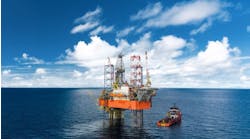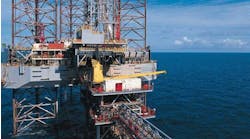Well control, leak containment efforts show massive commitment
Jay Schempf - Contributing Editor
A month or more ago, a single case of ongoing high-risk exploratory drilling in the ultra-deepwater of the Gulf of Mexico resulted in:
- A deplorable loss of human life
- The fouling of some sensitive marshlands along Louisiana’s transition zone, with more likely
- The threat – at least for the short term – to the viability of the Gulf Coast commercial fishing and shrimping industry, which already is in trouble
- A wave of blame-seeking and recriminations that extends from the offshore petroleum industry and U.S. Gulf Coast states to – and from – the halls of Congress and the offices of the Obama Administration.
The case in point, of course, was the April 20 explosion and fire aboard Transocean’sDeepwater Horizon, a fifth-generation ultra-deepwater semisubmersible mobile offshore drilling unit (MODU), which resulted in the apparent deaths of 11 missing members of the rig’s onboard complement of 126 workers and 17 others injured, three critically.
The rig was on location after finalizing the drilling of an exploratory well on the Macondo prospect, spudded in February in about 5,000 ft (1,524 m) of water in Mississippi Canyon block 252 (MC 252). At the time of the fatal incident, the British Petroleum Plc operated well had been drilled to measured drilled depth of about 18,500 ft (5,639 m).
The deepwater well site is located about 52 mi (84 km) southeast of Venice, Louisiana.
Only hours after it was reported to state and federal authorities, first responders arrived at the burning rig. Responders included the U.S. Coast Guard, which dispatched both cutters and smaller craft to the scene.. Meanwhile, privately owned standby vessels assisted in rescuing the 96 crewmembers who were found both in lifeboats and swimming. Both Coast Guard and privately owned supply vessels brought firefighting equipment to bear on the blazing rig, the fires fueled by the escaping natural gas from the well and allegedly abetted by leaking diesel fuel from permanent tanks aboard the rig itself. More vessels arrived at the scene during the next two days.
Despite the efforts to save it by drenching the raging fires with sea water, the rig, valued at more than $560 million, sank on April 22, coming to a rest upside-down on the sea floor some 1,500 ft (457 m) northwest of the well center, fortunately away from subsea pipelines in the immediate area.
‘Sheen’ gives way to leaks
After the rig sank, search and rescue aircraft on April 23 reported a 5-mi (8-km)-long oil “sheen” drifting away from the well area. This was thought to be coming from the sunken rig, and no oil was reported to be leaking from the well.
On April 24, however, four ROVs dispatched at BP’s behest to survey the drilling riser and the seafloor BOP stack, reported that oil was leaking from a break in the collapsed riser as well as from the top of the drillstring, which was found to be lodged in the BOP, which reportedly failed to close off the well when the rig fire occurred. The leaks at first were estimated to total about 1,000 b/d of crude oil with associated natural gas.
The next day, the Coast Guard elevated the spill response and established a regional command center and joint information center in Robert, Louisiana. At the same time, over flights described a drifting oil slick about 48 mi (77 km) wide and 39 mi (63 km) long, which was assumed to be emanating from the underwater leaks. Both the U.S. departments of Interior and Homeland Security announced on April 27 that a joint investigation would be mounted to pinpoint the cause of the accident.
Controlled burns, changing numbers and the ‘blame game’
On April 28, the Coast Guard approved “controlled burns” of contained crude oil to slow the spread of the slick, which had fingered outward, both toward and away from the shores of southeastern Louisiana and western Mississippi and Alabama. The surface oil would be contained by small boats trailing floating U-shaped booms and then burned in small quantities, weather permitting.
Also on April 28, BP informed authorities that the total riser and well leak volumes were larger than first thought, with the estimated total going to 5,000 b/d.
In Washington, D.C., US President Barack Obama pledged on April 30 that “every single, available resource,” including the U.S. military, would be called upon to contribute manpower and spill abatement materiel to the various federal, state, and local efforts to contain the oil and to anticipate its potential for coming ashore.
The president also stated that as operator of the Macondo project well, BP is solely responsible for all cleanup costs, presumably for long as it takes to return the Gulf, the U.S. southern coastline, and any other affected U.S. lands or waters to as close to pre-spill conditions as possible.
Perhaps anticipating the beginning of the “blame game,” BP Group Chief Executive Tony Hayward, in a round of appearances on morning television and radio news shows over the weekend of May 1-3 said the company would assume the cleanup costs connected to the oil leak. He also said BP would pay compensation for “legitimate” claims for property damage, personal injury, and business losses.
“We are responsible, not for the accident, but we are responsible for the oil and for dealing with it and cleaning the situation up,” Hayward said.
While Hayward conducted his media blitz, President Obama flew from Washington to south Louisiana on May 2, where he viewed cleanup efforts firsthand, reiterating BP’s responsibility therein.
Leak-stopping takes multiple paths
Only hours after theDeepwater Horizon sunk beneath the fiery waves on April 22 and the oil slick indicated the Macondo prospect well was leaking, the U.S. Coast Guard first responders, along with BP and other Gulf Coast marine industry entities, was locating and employing oil containment booms, shipping dispersants to staging areas along the coast for both aerial and sea surface application, and marshalling oil skimming vessels to the area.
According to records supplied by the federalDeepwater Horizon Unified Command, which is the overall body made up of federal, state, and local responding organizations, the air and surface fleet sent to the Deepwater Horizon scene as of April 20 was comprised of two USCG cutters and four helicopters and fixed-wing aircraft. This was enhanced by an undetermined number of private vessels and helicopters supplied either by BP or its subcontractors. The number of persons on the scene was not determined.
By May 20, however, combining both the Unified Command’s and BP’s cumulative figures, the human and mechanical oil spill cleanup totals included:
- More than 24,000 respondents assigned to protect the shoreline and wildlife
- More than 1,000 vessels responding on site, including skimmers, tugs, barges, and recovery vessels to assist in containment and cleanup efforts – in addition to dozens of aircraft, remotely operated vehicles, and multiple mobile offshore drilling units
- More than 1.9 million ft (578,000 m) of containment and sorbent boom had been deployed to contain the spill, and about 370,000 ft (121,776 m) of containment boom and 1.28 million ft (390,144 m) of sorbent boom still were available
- Approximately 8.3 million gal (31.4 million l) of oil/water mix had been recovered
- Approximately 655,000 gal (2,47 million l) of total dispersant had been deployed and more than 340,000 gal (1.29 million l) were still available
- 17 staging areas were in place and ready to protect sensitive shorelines, including: Dauphin Island, Orange Beach and Theodore, Alabama; Panama City, Pensacola, Port St. Joe, and St. Marks, Florida; Amelia, Cocodrie, Grand Isle, Shell Beach, Slidell, St. Mary, and Venice, Louisiana; plus Biloxi, Pascagoula, and Pass Christian, Mississippi.
Relief drilling summoned early
Almost as quickly after the rig personnel were brought to shore to be welcomed by their families, BP applied to the Minerals Management Service for permits to drill not one, but two relief wells to intercept the Macombo wellbore at a point below the producing formation in order to plug it and stop the uncontrolled flow to the surface.
BP also contracted for two of Transocean’s giant Development Driller class twin derrick drilling/completion rigs,Development Driller III and Development Driller II, to drill the relief wells. The permits were granted and DD III spudded its well on May 2. Due to permitting delays, the DDII, having arrived at its intercept well site several days later, had not spudded as Offshore went to press.
But the efforts to stop the leaks did not stop there.
BP also called not only on the engineering talent from its own U.S. group’s operations, but also those from its London-based parent company. Spurred by the pressure to stop the leaking oil at any cost, but staying as much within acknowledged drilling and oil recovery technologies as possible, BP engineers and subcontractors pursued several initiatives with leak-stopping in mind.
Several of the designs, while attainable in many areas of the world, would be used for the first time in ultra-deepwater, where extreme pressures, subsea currents, and cold water temperatures create significant challenges to established offshore engineering values.
Combing for a dome
When it became obvious that theDeepwater Horizon’s BOP – situated on the seafloor far beyond human intervention – could not be manipulated successfully by unmanned, tethered ROVs, the call went out for fabrication of a modified concrete cofferdam, designed originally for use in shallow water recovery efforts after Hurricane Katrina. The cofferdams were lowered over Katrina-damaged wellheads to allow divers to repair them underwater. Fortunately, BP had been working with the cofferdam fabricators, Wild Well Controls Inc., to convert such structures for use in deeper water.
From such a cofferdam, the companies designed what BP calls the Subsea Oil Recovery System – a large containment structure to be placed over the largest leak source in the BOP stack to collect hydrocarbons from the well and to pump them to a surface storage vessel.
The dome-topped containment system consists of a 125-ton (113 metric ton), 40-ft (12.2-m)-high structure with equipment at the top connected to a 5,000-ft riser that would convey the oil to the surface vessel for processing and storage – in this instance Transocean’s deepwater drillshipDiscoverer Enterprise – prior to offloading into a tanker.
The containment dome was fabricated in a round-the-clock operation and transported by barge on May 4 to the drillship, already anchored to the side of the leak site. As it was maneuvered by ROVs over the targeted BOP leak, the oil, gas, and sea water captured naturally inside the dome as it was lowered resulted in the formation of gas hydrates, which quickly clogged the collection system at the top. The potential delays involved in bringing the dome back to the surface for cleaning and further modification compelled BP to “park” it on the seafloor near the leak with the possibility of reactivating it at a later time.
‘Top Hat’ sails, then tails
Still faithful to the containment dome idea, BP and Wild Well Control then designed and modified a much smaller domed structure, weighing only 2 tons (1.8 metric tons), called the “Top Hat” system, that would connect to the leak by drill pipe and a riser from the drillship itself. Because of its smaller size, engineers posit, the smaller dome would not collect as much sea water. Combined with injection of hot water and inhibition chemical (methanol) into the dome via umbilicals, they theorize that the formation of hydrates would be minimized.
The Top Hat dome was lowered to the seabed awaiting deployment; however, since other, more direct intervention initiatives consigned it to the “Plan B” corner for the time being.
RITT system recovers some leaking oil
According to BP, further examination of the failed BOP using ROVs and various diagnostic techniques, increased engineers’ understanding of its condition and allowed planning to continue on a number of potential interventions. Principal among these intervention methods was the fast-paced design of what BP calls the Riser Insertion Tube Tool (RITT).
The tool system involves using the ROVs to insert a 5-ft (1.5-m)-long, 4-in. diameter tube into theDeepwater Horizon’s broken 21-in. diameter riser on the seafloor, between its broken end nearest the well – a distance of some 600 ft (183 m).
Development Driller rig at work on a relief well. Photo courtesy of US Coast Guard.
The insertion tube would be connected to drill pipe inside the new riser aboard theDiscoverer Enterprise drillship to allow oil to flow up for separation and storage, and then offloading for tanker/barge shipment ashore, with the associated gas being flared. The methanol-based inhibitor treatment system originally planned for use with the Top Hat would be used similarly in the RITT.
The RITT was placed at the end of the leaking riser on May 16 and BP reported oil recovery was averaging 2,000 b/d, or about 40% of the reported 5,000 b/d total coming from all leaks. By May 20, the company was reporting a 3,000-b/d recovery rate from the RITT.
‘Top kill’ with junk becomes possible
Early in its leak-stopping activity, BP used ROV technology to install a valve at the end of the broken drill pipe lodged in the well and protruding from the length of riser remaining atop the BOP. This not only stopped a smaller leak from that point, but also raised the possibility of attempting a “top kill” of the well by hot tapping into that riser section and installing another BOP or other valve.
This would allow the drillship to inject materials into the well bore along with heavy drilling fluid to equalize the pressure differential, and then pumping cement on top to effectively plug the well while awaiting the 70 or so days for the relief wells to reach their objectives at the bottom of the well bore.
While such an operation is almost routine for killing well “kicks” and correcting pressure control losses both on land and offshore, it would once again be attempted in a water depth of 5,000 ft, so BP drilling and completion engineers were pondering the top kill option very carefully. In fact, as of press time, a top kill operation was still in the planning stages.
As of May 20, various estimates of the total oil leaked from the Macondo prospect well had averaged to somewhere around 90,000 bbls, given the recovery of 3,000 b/d with the RITT system.
As serious as it is, this leakage rate could be compared favorably to the average daily total of some 10,000 b/d of heavy oil from the June 1979 IxToc I well blowout in Mexico’s Bay of Campeche – the largest offshore drilling oil spill in history. If the Macondo prospect well ultimately will be killed in some 70 days, it conceivably will have leaked a total of around 210,000 bbl.
The Ixtoc I blowout leaked a total of 3 MMbbl of oil before it was killed by a relief well in March 1980. The oil ultimately covered an area of 1,100 sq mi (2,800 sq. km), and impacted 162 mi (261 km) of the Mexico/South Texas coastline. And while the Ixtoc overall impact altered very little industrial infrastructure nor severely affected relatively fewer individual Mexican fishermen’s lives, its effects have long since been proven to have been minimal, at worst.
Nevertheless, the anti-industry political and public response to the Macondo prospect rig fire and continued oil spill will no doubt continue to reverberate around the world for years, if not decades. It will definitely result in creative new deepwater drilling and production technologies.
But whether it will once again stymie future prospects for offshore oil and gas development in U.S. waters remains to be seen.








